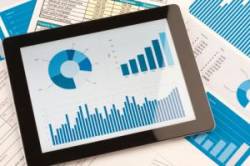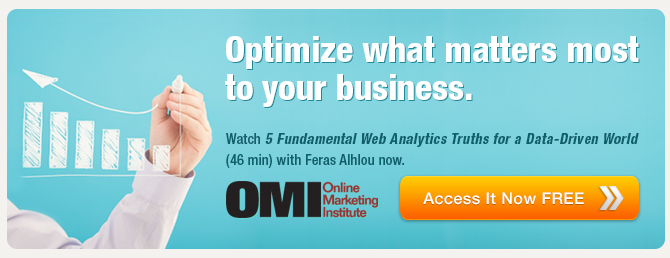 As it has been shown in a variety of ways over the past decade or so, the days of math-less, mindless, off-the-hip marketing have long set sail. So how do the once gun-slinging marketers of the past begin to tackle the voluminous unstructured data that is collected from nontraditional sources to harness the power of analytics? Big Data, derived from blogs, social media, email, sensors, photographs, video footage, etc. is and has always been the answer. Although Big Data isn’t new, most marketers are still wrapping their heads around the transformation of raw data into action. RELATED CLASS: Big Data, Big Analytics: Measuring What Matters
As it has been shown in a variety of ways over the past decade or so, the days of math-less, mindless, off-the-hip marketing have long set sail. So how do the once gun-slinging marketers of the past begin to tackle the voluminous unstructured data that is collected from nontraditional sources to harness the power of analytics? Big Data, derived from blogs, social media, email, sensors, photographs, video footage, etc. is and has always been the answer. Although Big Data isn’t new, most marketers are still wrapping their heads around the transformation of raw data into action. RELATED CLASS: Big Data, Big Analytics: Measuring What Matters
Data vs. Insight
In today's data-rich and data-driven environment, we are predisposed to gain our insights from data. But action doesn't always follow collection. A survey of 600 executives by the Economist Intelligence Unit found that 85% of the participants thought the biggest hurdle to unlocking value from data was not grappling with the sheer volume, but analyzing and acting on it. And gleaning the insights from the data is what makes the data valuable.
Merriam-Webster defines insight as the power or act of seeing. Keyword: Seeing. We must use the data to identify and see—to see patterns, trends, and anomalies. And once we gain this insight, its value is proven by the actions we take as result. Data that doesn't help you see isn't useful. So, in this instance, more does not always translate into better insights. In fact, according to the recently released 5th annual Digital IQ Survey, consulting firm Pricewaterhouse Coopers (PwC) found that 58% of respondents agree that moving from data to insight is a major challenge.
In 1990, Stephen Tuthill at 3M helped make the connection between data and wisdom. His The Data Hierarchy outlines four important concepts: data, information, knowledge, and wisdom, with data being the raw items or events. Once we have the data, we can sort and organize it into information. Knowledge is then derived from the patterns that result from understanding the relationships between the data and other factors. Wisdom comes when we understand what to pay attention to—what has meaning for us.
So, rather than focusing on more data, we need to focus on capturing the right data and then analyzing it in a way that gives us the power to see (knowledge) and act (wisdom). Bernard Marr from UK-based Advanced Performance Institute reminds us that to get the most out our data "you need to know what you want to know." Once you know what you want to know, collect and organize the data.
Now what?
Getting From Data to Insight
1. Bring data to life with visualization
Having the data is one thing, analyzing and synthesizing it is another. Synthesis is where we begin to see the patterns. Once the synthesis is completed, you will need a way to bring the data to life. Data visualization greatly aids in this part of the process. Data visualization presents analytical results visually so we can more easily see what's relevant among all the variables, capture and communicate important patterns, and even support predictive models. Visualization is an important step for exposing trends and patterns that you might not have otherwise noticed.
2. Discuss patterns and the potential implications
Not all patterns are germane. Take the time to review and discuss each pattern and its potential implications. Talk about why you think each pattern is important and what it means. This is an essential step for going from information to knowledge.
3. Articulate the insight that emerged from each pattern
In one simple statement, articulate the insight that emerged out of each pattern or point of synthesis. We find it is helpful to capture insight on a Post-it Note and place it on a wall or flip chart to easily track each insight and see the "big picture" that may be emerging as we go.
4. Incubate the insights
Give yourself and your team at least a day away from the "board." When you and the team return you can take a fresh look and decide whether to make any changes.
5. Get reactions from others
Do the insights resonate? Once you are comfortable with the conclusions/insights you've captured, involve other people who were part of the initial steps to gain their reactions. Be sure to give them the context. The point of this step is to decide if the insights resonate and are compelling enough to make or affect key decisions. That is, to determine whether you have acquired the wisdom you need to act.
The success of this approach is contingent on the quality (not necessarily the quantity) of the data set, then following a process proven to identify core insights to support strategic decisions. Just like traversing your daily route to and from work, gaining insights from data becomes innate. Although intuition of the traditional sense is still a valuable tool to modern marketers, data has become the insurance policy in understanding our customers. Our ability to “read in numbers” has become paramount. For more information, read VisionEdge Marketing’s White Paper, From Intuition to Wisdom: Transforming Data into Models and Actionable Insights.
Take your web analytics practice to the next level.
Watch the OMI tutorial, 5 Fundamental Web Analytics Truths for a Data-Driven World with Feras Alhlou, and learn how to develop a web analytics practice that enables you to optimize what matters most to your business, and ignore the rest. Access it FREE with a 7-day trial to the Online Marketing Institute. Activate trial now.
